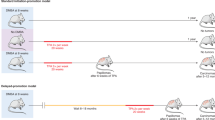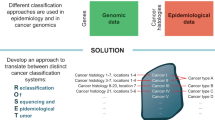Abstract
Age-specific cancer rates show large historical increases that indict environmental risk factors. But these environmental factors did not necessarily act by increasing oncomutation rates. Mathematical analyses suggest selective effects on pre-existing oncomutants. The widely held hypothesis that environmental chemicals induce a substantial fraction of human point mutations has not been supported by observation. Direct measurement of the kinds and numbers of point mutations in human tissues have, in fact, found no clear relationship with exposure to environmental agents, save for sunlight in the skin. Alternative hypotheses that point mutations arise primarily as errors during turnover of undamaged DNA and that environmental conditions select rather than induce oncomutants seem to better explain the facts of environmental carcinogenesis in humans.
This is a preview of subscription content, access via your institution
Access options
Subscribe to this journal
Receive 12 print issues and online access
$209.00 per year
only $17.42 per issue
Buy this article
- Purchase on Springer Link
- Instant access to full article PDF
Prices may be subject to local taxes which are calculated during checkout

Similar content being viewed by others
References
U.S. Department of Health and Human Services. Vital Statistics of the United States (U.S. Government Printing Office, Hyattsville, Maryland, 1937–1992).
U.S. Bureau of the Census. Mortality Statistics (Washington Government Printing Office, Washington D.C., 1900–1936).
Kinzler, K.W. & Vogelstein, B. Cancer-susceptibility genes. Gatekeepers and caretakers. Nature 386, 761–763 (1997).
Coller, H.A. & Thilly, W.G. Development and applications of mutational spectra technology. Env. Sci. Technol. 28, 478–487 (1994).
Kensler, T.W., Groopman, J.D. & Wogan, G.N. Use of carcinogen–DNA and carcinogen–protein adduct biomarkers for cohort selection and as modifiable end points in chemoprevention trials. IARC Sci. Publ. 139, 237–248 (1996).
Thilly, W.G. Chemicals, genetic damage and the search for truth. Technol. Rev. 83, 37–41 (1981).
Holmquist, G.P. Endogenous lesions, S-phase-independent spontaneous mutations, and evolutionary strategies for base excision repair. Mutat. Res. 400, 59–68 (1998).
Morley, A.A. & Turner, D.R. The contribution of exogenous and endogenous mutagens to in vivo mutations. Mutat. Res. 428, 11–15 (1999).
Herrero-Jimenez, P. et al. Mutation, cell kinetics, and subpopulations at risk for colon cancer in the United States. Mutat. Res. 400, 553–578 (1998).
Herrero-Jimenez, P., Tomita-Mitchell, A., Furth, E.E., Morgenthaler, S. & Thilly, W.G. Population risk and physiological parameters for colon cancer. The union of an explicit model for carcinogenesis with the public health records of the United States. Mutat. Res. 447, 73–116 (2000).
Herrero-Jimenez, P. Determination of the historical changes in primary and secondary risk factors for cancer using U.S. public health records. (Massachusetts Institute of Technology Press, Cambridge, 2001).
Erb, L.T. A mathematical model of pancreatic cancer implicating industrialization as an environmental risk factor. (Massachusetts Institute of Technology Press, Cambridge, 2002).
Vodicka, P. et al. Biomarkers of styrene exposure in lamination workers: levels of O6-guanine DNA adducts, DNA strand breaks and mutant frequencies in the hypoxanthine guaninephosphoribosyltransferase gene in T-lymphocytes. Carcinogenesis 16, 1473–1481 (1995).
Khrapko, K. et al. Mitochondrial mutational spectra in human cells and tissues. Proc. Natl. Acad. Sci. USA 94, 13798–13803 (1997).
Alexandrov, K. et al. An improved fluorometric assay for dosimetry of benzo(a)pyrene diol-epoxide-DNA adducts in smokers' lung: comparisons with total bulky adducts and aryl hydrocarbon hydroxylase activity. Cancer Res. 52, 6248–6253 (1992).
Coller, H.A. et al. Mitochondrial mutational spectra in smokers and nonsmokers. Mutational spectra of a 100 base pair mitochondrial DNA target sequence in bronchial epithelial cells: a comparison of smoking and nonsmoking twins. Cancer Res. 58, 1268–1277 (1998).
Dunn, J.E. Cancer epidemiology in populations of the United States—with emphasis on Hawaii and California—and Japan. Cancer Res. 35, 3240–3245 (1975).
Lichtenstein, P. et al. Environmental and heritable factors in the causation of cancer—analyses of cohorts of twins from Sweden, Denmark, and Finland. N. Engl. J. Med. 343, 78–85 (2000).
Dong, C. & Hemminki, K. Modification of cancer risks in offspring by sibling and parental cancers from 2,112,616 nuclear families. Int. J. Cancer 92, 144–150 (2001).
Luebeck, E.G., Heidenreich, W.F., Hazelton, W.D., Paretzke, H.G. & Moolgavkar, S.H. Biologically based analysis of the data for the Colorado uranium miners cohort: age, dose and dose-rate effects. Radiat. Res. 152, 339–351 (1999).
Burns, F.J., Vanderlaan, M., Sivak, A. & Albert, R.E. Regression kinetics of mouse skin papillomas. Cancer Res. 36, 1422–1427 (1976).
Benzer, S. & Freese, E. Induction of specific mutations with 5-bromouracil. Proc. Natl. Acad. Sci. USA 44, 112–119 (1958).
Cooper, D.N., Ball, E.V. & Krawczak, M. The human gene mutation database. Nucleic Acids Res. 26, 285–287 (1998).
Hainaut, P. et al. IARC Database of p53 gene mutations in human tumors and cell lines: updated compilation, revised formats and new visualisation tools. Nucleic Acids Res. 26, 205–213 (1998).
Cariello, N.F. et al. Databases and software for the analysis of mutations in the human p53 gene, human hprt gene and both the lacI and lacZ gene in transgenic rodents. Nucleic Acids Res. 26, 198–199 (1998).
Oller, A.R. & Thilly, W.G. Mutational spectra in human B-cells. Spontaneous, oxygen and hydrogen peroxide-induced mutations at the hprt gene. J. Mol. Biol. 228, 813–826 (1992).
Cariello, N.F., Keohavong, P., Kat, A.G. & Thilly, W.G. Molecular analysis of complex human cell populations: mutational spectra of MNNG and ICR-191. Mutat. Res. 231, 165–176 (1990).
Zarbl, H., Sukumar, S., Arthur, A.V., Martin-Zanca, D. & Barbacid, M. Direct mutagenesis of Ha-ras-1 oncogenes by N-nitroso-N-methylurea during initiation of mammary carcinogenesis in rats. Nature 315, 382–385 (1985).
Cha, R.S., Thilly, W.G. & Zarbl, H. N-Nitroso-N-methylurea-induced rat mammary tumors arise from cells with preexisting oncogenic Hras-1 gene mutations. Proc. Natl. Acad. Sci. USA 91, 3749–3753 (1994).
Jin, Z., Houle, B., Mikheev, A.M., Cha, R.S. & Zarbl, H. Alterations in H-ras1 promoter conformation during N-nitroso-N-methylurea-induced mammary carcinogenesis and pregnancy. Cancer Res. 56, 4927–4935 (1996).
Albertini, R.J., Castle, K.L & Borcherding, W.R. T-cell cloning to detect the mutant 6-thioguanine-resistant lymphocytes present in human peripheral blood. Proc. Natl. Acad. Sci. USA 79, 6617–6621 (1982).
Brash, D.E. et al. A role for sunlight in skin cancer: UV-induced p53 mutations in squamous cell carcinoma. Proc. Natl. Acad. Sci. USA 88, 10124–10128 (1991).
Ziegler, A. et al. Sunburn and p53 in the onset of skin cancer. Nature 372, 730 (1994).
Nakazawa, H. et al. UV and skin cancer: specific p53 gene mutation in normal skin as a biologically relevant exposure measurement. Proc. Natl. Acad. Sci. USA 91, 360–364 (1994).
Zhang, W., Remenyik, E., Zelterman, D., Brash, D.E. & Wikonkal, N.M. Escaping the stem cell compartment: sustained UVB exposure allows p53-mutant keratinocytes to colonize adjacent epidermal proliferating units without incurring additional mutations. Proc. Natl. Acad. Sci. USA 98, 13948–13953 (2001).
Brash, D.E. & Ponten, J. Skin precancer. Cancer Surv. 32, 69–113 (1998).
Wynder, E.L. & Graham, E.A. Tobacco smoking as a possible etiologic factor in bronchogenic carcinoma: a study of six hundred and eighty four proved cases. J. Amer. Med. Assoc. 143, 329–336 (1950).
Burkhart-Schultz, K.J., Thompson, C.L. & Jones, I.M. Spectrum of somatic mutation at the hypoxanthine phosphoribosyltransferase (hprt) gene of healthy people. Carcinogenesis 17, 1871–1883 (1996).
Podlutsky, A., Hou, S.M., Nyberg, F., Pershagen, G. & Lambert, B. Influence of smoking and donor age on the spectrum of in vivo mutation at the HPRT locus in T lymphocytes of healthy adults. Mutat. Res. 431, 325–339 (1999).
Curry, J., Karnaoukhova, L., Guenette, G.C. & Glickman, B.W. Influence of sex, smoking and age on human hprt mutation frequencies and spectra. Genetics 152, 1065–1077 (1999).
Rodin, S.N. & Rodin, A.S. Human lung cancer and p53: the interplay between mutagenesis and selection. Proc. Natl. Acad. Sci. USA 97, 12244–12249 (2000).
Hainaut, P. & Pfeifer, G.P. Patterns of p53 G→T transversions in lung cancers reflect the primary mutagenic signature of DNA-damage by tobacco smoke. Carcinogenesis 22, 367–374 (2001).
Wallace, D.C. Mitochondrial diseases in man and mouse. Science 283, 1482–1488 (1999).
Coller, H.A. et al. High frequency of homoplasmic mitochondrial DNA mutations in human tumors can be explained without selection. Nat. Genet. 28, 147–150 (2001).
Holmquist, G.P. Chronic low-dose lesion equilibrium along genes: measurement, molecular epidemiology, and theory of the minimal relevant dose. Mutat. Res. 405, 155–159 (1998).
Yang, K., Fang, J.L. & Hemminki, K. Abundant lipophilic DNA adducts in human tissues. Mutat. Res. 422, 285–295 (1998).
Lindahl, T. Instability and decay of the primary structure of DNA. Nature 362, 709–715 (1993).
Pelc, S. Metabolic DNA in ciliated protozoa, salivary gland chromosomes, and mammalian cells. Int. Rev. Cytol. 32, 327–355 (1972).
Grivell, A.R., Grivell, M.B. & Hanawalt, P.C. Turnover in bacterial DNA containing thymine or 5-bromouracil. J. Mol. Biol. 98, 219–233 (1975).
Albertini, R.J. et al. Biomarkers for assessing occupational exposures to 1,3-butadiene. Chem. Biol. Interact. 135–136, 429–453 (2001).
Vodicka, P. et al. An evaluation of styrene genotoxicity using several biomarkers in a 3-year follow-up study of hand-lamination workers. Mutat. Res. 445, 205–224 (1999).
Muniappan, B.P. & Thilly, W.G. The DNA polymerase β error spectrum in adenomatous polyposis coli gene contains human colon tumor mutational hotspots. Cancer Res. 62, 3271–3275 (2002).
Branum, M.E., Reardon, J.T. & Sancar, A. DNA repair excision nuclease attacks undamaged DNA. A potential source of spontaneous mutations. J. Biol. Chem. 276, 25421–25426 (2001).
Tomita-Mitchell, A. et al. The mutational spectrum of the HPRT gene from human T cells in vivo share a significant concordant set of hotspots with MNNG treated human cells. Cancer Res. (in the press).
Armitage, P. & Doll, R. A two-stage theory of carcinogenesis in relation to the age distribution of human cancer. Br. J. Cancer 9, 161–169 (1957).
Acknowledgements
The author wishes to acknowledge the assistance of dozens of colleagues and students in honing the arguments presented herein, especially K. Hemminki, S. Morgenthaler, L. Ehrenberg, D. Brash, P. Hanawalt, A. Morley and E. Gostjeva.
Author information
Authors and Affiliations
Rights and permissions
About this article
Cite this article
Thilly, W. Have environmental mutagens caused oncomutations in people?. Nat Genet 34, 255–259 (2003). https://doi.org/10.1038/ng1205
Received:
Accepted:
Published:
Issue Date:
DOI: https://doi.org/10.1038/ng1205
This article is cited by
-
Antioxidant and hepatoprotective potential of Lawsonia inermis L. leaves against 2-acetylaminofluorene induced hepatic damage in male Wistar rats
BMC Complementary and Alternative Medicine (2017)
-
Action Spectrum Analysis of UVR Genotoxicity for Skin: The Border Wavelengths between UVA and UVB Can Bring Serious Mutation Loads to Skin
Journal of Investigative Dermatology (2013)
-
The nucleotide excision repair (NER) system of Helicobacter pylori: Role in mutation prevention and chromosomal import patterns after natural transformation
BMC Microbiology (2012)
-
Large-scale inference of the point mutational spectrum in human segmental duplications
BMC Genomics (2009)
-
Mutational spectra of human cancer
Human Genetics (2009)



